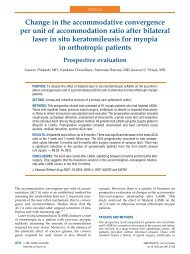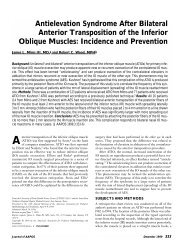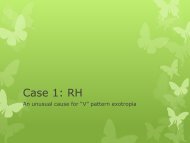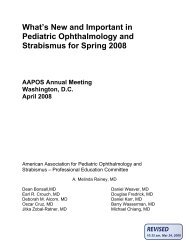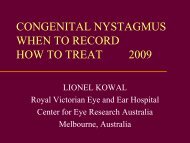Epidemiology of amblyopia - The Private Eye Clinic
Epidemiology of amblyopia - The Private Eye Clinic
Epidemiology of amblyopia - The Private Eye Clinic
You also want an ePaper? Increase the reach of your titles
YUMPU automatically turns print PDFs into web optimized ePapers that Google loves.
Seminar<br />
others do not. 72,74,75 Parents or carers having to deal with<br />
distressed, uncomfortable, and visually-impaired<br />
children wearing the patch should be given information,<br />
convinced <strong>of</strong> the need for treatment, 76,77 and appropriately<br />
motivated to treat. 78,79 Parents or carers giving older<br />
children a role in monitoring their own treatment—eg,<br />
with the use <strong>of</strong> patching diaries with stickers—could<br />
help. Active, unreasonable toddlers pose the biggest<br />
challenge. Behavioural modification programmes might<br />
also help children and families. 80<br />
Patches can also be stuck onto spectacles, but this<br />
method gives the child the opportunity to look around<br />
them. Felt patches, which slide over the spectacle lens,<br />
have a side-piece that helps prevent the child looking<br />
around the patch but are cosmetically obtrusive.<br />
Translucent material such as blenderm or Bangerter<br />
filters (Fresnel Prism and Lens Co LLC, Eden Praire,<br />
MN, USA) are more cosmetically acceptable but have<br />
not been rigorously studied.<br />
Some concerns have been raised regarding the<br />
emotional effect <strong>of</strong> <strong>amblyopia</strong> treatment, 43 but in a<br />
PEDIG study, 63 both atropine and patching treatments<br />
seemed to be well tolerated by assessment with a parental<br />
questionnaire. Additionally, several other studies 81,82 have<br />
shown minimum emotional effect from <strong>amblyopia</strong><br />
treatment.<br />
Effective ages at which to treat <strong>amblyopia</strong><br />
<strong>The</strong> duration <strong>of</strong> a sensitive period for <strong>amblyopia</strong><br />
treatment seems to vary depending on the cause <strong>of</strong> the<br />
disorder. Causes that severely degrade the retinal image<br />
early in infancy (usually the stimulus deprivation type <strong>of</strong><br />
<strong>amblyopia</strong>—eg, caused by congenital cataract) need<br />
early, vigorous treatment. Causes with a late onset could<br />
respond to treatment given well into late childhood and<br />
after.<br />
In a PEDIG trial, 14 no effect <strong>of</strong> age was found at the<br />
6-month primary outcome in children aged 3 to less than<br />
7 years, and only a very small effect was seen at the 2-<br />
year follow-up, 61 with children aged 6–7 years having a<br />
slightly worse outcome (3·2 lines improvement) than<br />
those aged less than 4 years (3·9), 4–5 years (3·7), and<br />
5–6 years (3·7). A similar absence <strong>of</strong> age effect was seen<br />
in a 2-h versus 6-h randomised trial; 38 however, a fulltime<br />
versus part-time trial 54 did show reduced<br />
improvement in the older children. Nevertheless, these<br />
two patching regimen trials were only designed to have<br />
4 months’ follow-up, and not to indicate maximum<br />
improvement.<br />
In a randomised trial 83 enrolling 7 to 17-year-old<br />
individuals with anisometropic and strabismic <strong>amblyopia</strong><br />
ranging from 6/12 to 6/120, 53% <strong>of</strong> 7 to 12-year-old<br />
children responded to patching, atropine, near activities,<br />
and optical correction, whereas 25% responded to optical<br />
correction alone (response was defined as at least ten<br />
letters on the ETDRS chart—ie, two lines). 83 In 13 to 17-<br />
year-old individuals, similar proportions responded to<br />
patching-optical correction and optical correction alone<br />
(25% and 23%, respectively), although those who had<br />
not been previously treated had a higher response rate<br />
than those who had been previously treated (47% vs<br />
20%). <strong>The</strong>se data support previous reports 84–86 that<br />
<strong>amblyopia</strong> can be treated beyond age 7 years. What is<br />
unclear, and will be forthcoming in long-term follow-up<br />
data, 83 is whether these improvements in visual acuity<br />
are sustained, similar to the younger age group, in which<br />
2-year follow-up data are available. 61<br />
Does <strong>amblyopia</strong> treatment work<br />
<strong>The</strong>re has been some skepticism 43 about the effectiveness<br />
<strong>of</strong> <strong>amblyopia</strong> treatment, because until recently, 70,87 few<br />
studies have included untreated controls in their design.<br />
Some researchers have suggested that many instances <strong>of</strong><br />
<strong>amblyopia</strong> are due to a congenital and permanent opticnerve<br />
abnormality, 88,89 which would be expected to be<br />
completely resistant to any intervention. <strong>The</strong> reluctance<br />
to design studies with untreated controls has resulted<br />
from the previous feeling <strong>of</strong> urgency to treat, due to the<br />
potential closing <strong>of</strong> a window <strong>of</strong> opportunity. <strong>The</strong> failure<br />
<strong>of</strong> several trials to find any relation between treatment<br />
effect and age in 3 to 7-year-old children, and the finding<br />
<strong>of</strong> response in 7 to 12-year-old children, increases the<br />
comfort level with studies that have an untreated control<br />
group.<br />
Of studies that have included untreated controls,<br />
Clarke and colleagues 87 showed that in a group <strong>of</strong><br />
children (mean age 4 years) who had failed preschool<br />
screening on account <strong>of</strong> poor vision in one eye, treatment<br />
resulted in a significant improvement in acuity. Subgroup<br />
analysis showed this benefit to be confined to children<br />
with visual acuity <strong>of</strong> 6/18 or worse in the eye with reduced<br />
acuity at presentation.<br />
Awan and co-workers 70 recorded no mean difference<br />
between 0, 3, and 6 h/day <strong>of</strong> prescribed patching in a<br />
short 12-week randomised trial, but the participants only<br />
had 6 weeks <strong>of</strong> spectacle wear before study entry, so<br />
some <strong>of</strong> the improvement in the 0-h group would have<br />
been expected to be due to continued optical treatment<br />
<strong>of</strong> <strong>amblyopia</strong> 57 and therefore potentially masked any<br />
dose-response treatment difference. In a secondary<br />
analysis, patients who actually wore the patch for 3–6 h/<br />
day had greater improvement than those who had no<br />
patching. A forthcoming PEDIG trial will report data<br />
comparing 2 h/day <strong>of</strong> patching with continued spectacle<br />
wear in children who had reached maximum visual<br />
acuity improvement with spectacle wear alone.<br />
Why is <strong>amblyopia</strong> treatment not always<br />
successful<br />
Evidence from retrospective case series 90 and more<br />
recent randomised trials 61 suggests that only about 50%<br />
<strong>of</strong> children achieve normal vision in the amblyopic eye.<br />
In the past, this effect has <strong>of</strong>ten been assumed to be<br />
because treatment has been started too late to be<br />
1348 www.thelancet.com Vol 367 April 22, 2006



